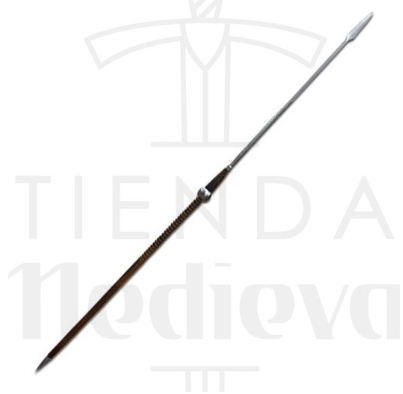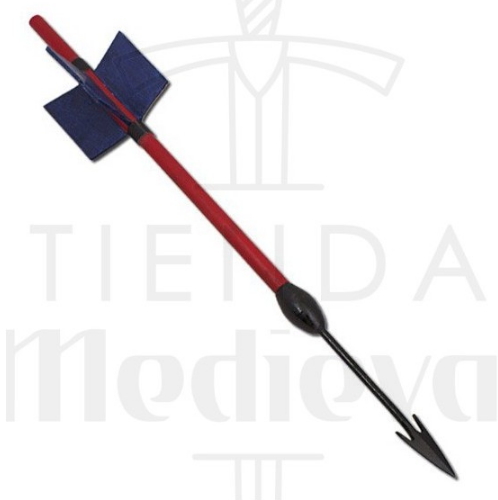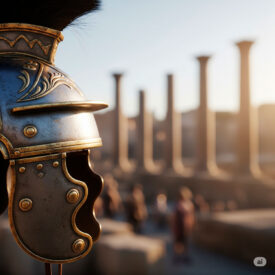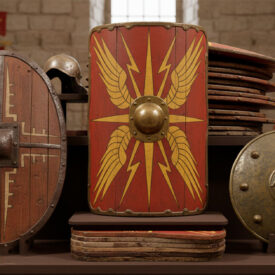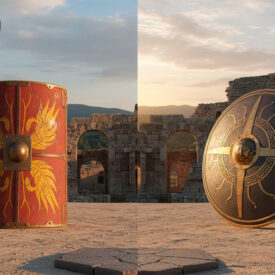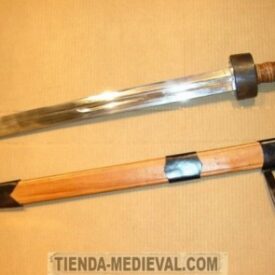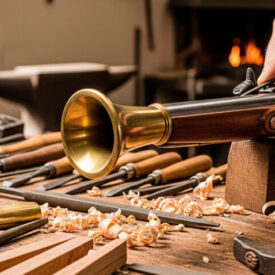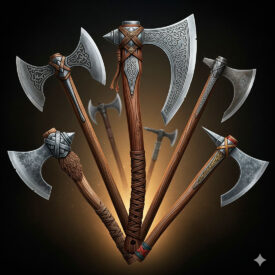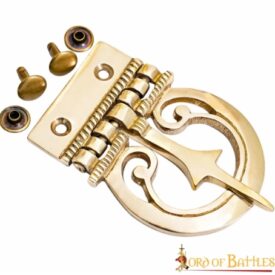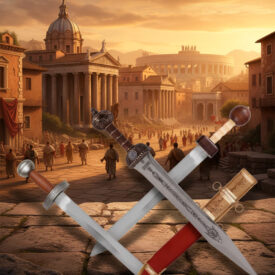Imagine a battlefield in ancient Rome, where a rain of projectiles marked the start of every engagement. The Roman legions, famed for their discipline and adaptability, perfected various throwing weapons throughout their long history. Two of the most emblematic, the pilum and the plumbata, are not only fascinating objects of study but also help us understand the constant evolution of the Roman army from the Empire’s height to its fall.
Was there really a decline in the quality of their weaponry, or was it a brilliant adaptation to new challenges? Join us to find out, exploring the differences, uses and evolution of these two throwing weapons that defined combat in Antiquity.
The Pilum: The Accurate Blow of the Classical Legions
The pilum was a fundamental weapon for the Roman legionary for centuries. Although the first clearly Roman examples are documented around the 3rd century BC, its use was very likely earlier. This formidable dart became a key part of the manipular army’s combat style.
What did a Pilum look like?
In essence, the pilum was an iron rod ending in a pyramidal point, attached to a wooden shaft. Its dimensions ranged between 1.5 and 2 metres, with a weight of 2 to 5 kilograms. A notable example is the metal head (moharra) of a heavy pilum found at La Caridad (Teruel), dated around 74 BC, which clearly shows its pyramidal point and a tongue for insertion into the wooden shaft. While the plumbata could measure between 50 and 60 cm, the pilum could measure between 215 and 225 cm.
The Myth of the Pilum That Bent
You have probably heard the myth that the pilum was designed to bend on impact with enemy shields, rendering them useless. While it is true that it could bend when striking a hard object, this was not an intentional design. In reality they were made of mild steel, a ductile material that deformed on impact. What really made the pilum so effective at disabling shields —capable of piercing up to 3 cm of wood— was its pyramidal head.
Once the wood was pierced, it tended to swell, making it extremely difficult to extract the head, which was larger than the shaft. If the pilum became stuck to the shield, even if it did not bend, the weight of the shaft made it unmanageable, forcing the enemy to drop it and leaving them at a disadvantage.
Tactical Use of the Pilum
The pilum’s range was limited, barely about 30 metres. Because of this, it is believed that soldiers in the front ranks carried a single pilum, while those in the rear ranks might carry a second. The launch of a “rain of pila” plunged the enemy into confusion, a moment the legionaries took advantage of to draw their swords and charge, using their shields offensively. Their aim was to break the enemy before the direct clash, comparable to modern artillery preparation. The pilum could wound the enemy directly or, by lodging in the shield, render it unusable or immobilise its bearer.
The Lancea: An Intermediate Step
The expansion of Roman frontiers and the rise of massed cavalry on eastern battlefields led to the development of the lancea from the 1st century AD. This weapon, lighter than the pilum and with a smaller leaf-shaped point, could be used both for throwing and for thrusting. It was adopted by cavalry and later by auxiliary infantry, often carrying one and two smaller ones behind the shield.
The lancea offered a greater range, approximately 80 metres, compared to the pilum, allowing legionaries to react earlier to enemy fire. Although it did not have the same penetration capacity as the pilum, its early use increased disorder in the enemy ranks.
The Plumbata: The Smart Dart of the Late Empire
The true innovation of the late 3rd century AD was the plumbata, also known as martiobarbulus (Mars’ dart). Its name, which means “lead-weighted spear”, already hints at its main feature. The Roman plumbata was a kind of arrow or spear mounted on a shaft with a lead weight that gave it mass and allowed it to be thrown by hand and penetrate enemy shields.
Design and Types
The plumbata was a dart or arrow with a lead ballast that gave it weight and allowed it to be thrown by hand, managing to pierce enemy shields. The main type, the plumbata mamillata, had a sharp circular-section point with a bulbous lead weight beneath, mounted on a shaft up to 50 cm long and finished with fins at the opposite end. There was another type, the plumbata tribolata, which supposedly had spikes on the lead weight to wound soldiers who trod on it, although no archaeological evidence of this variant has been found.
Use and Effectiveness
Each Roman soldier typically carried up to five of these projectiles inside his shield, ready to be thrown during a charge or from a defensive position. They were thrown with one hand and, according to experimental archaeology research, could reach up to 60 metres. This distance is double the range of the pilum or the lancea. Vegetius compared soldiers who threw the plumbata to archers, as they could wound the enemy before he entered the effective range of conventional projectiles.
The plumbata was a proven effective weapon against masses of infantry. Roman instructors placed great emphasis on training to increase throwing speed and strength. At the start of battles, Roman troops unleashed a true “rain of projectiles” on the enemy, an effective response to the defensive tactics of Germans, Persians and Sarmatians. This forced enemy troops to slow down and generated disorder in their ranks, allowing legionaries to halt the offensive or launch a counterattack. The plumbata gave the Roman legions a range that doubled that of the pilum, being shorter and lighter, without preventing the Roman legionary from using his scutum (shield) or quickly drawing his sword.
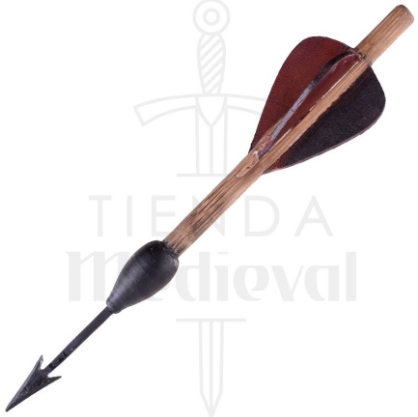
Pilum vs. Plumbata: A Battle of Adaptation
The evolution from pilum to plumbata was not a sign of decline, but of constant adaptation to new military scenarios and the new enemies Rome faced. The pilum was ideal for the frontal clash against large masses of infantry. However, it proved less effective against the armoured cavalry of Persians and Goths. The lancea tried to cover this need, but its range remained insufficient against the fearsome horse archers that populated Rome’s eastern frontiers from the 3rd century AD. It was then that the plumbata became necessary, providing Roman infantry with unprecedented range without preventing the use of the scutum (shield) or the quick drawing of the sword.
| Characteristic | Pilum | Plumbata |
|---|---|---|
| Penetration Power | Superior, capable of piercing shields and inflicting mortal wounds. | Good, capable of piercing shields and causing severe wounds, especially if the enemy was not armoured. |
| Range | Limited, approximately 30 metres. | Greater, up to 60 metres. |
| Quantity | 1 or 2 per legionary. | Up to 5 or 6 per legionary, allowing a larger initial volley of projectiles. |
| Main Use | Shock weapon before hand-to-hand combat against infantry. | Offensive and defensive weapon, allowing heavy infantry to combine roles with skirmishers. Effective against cavalry. |
| Disabling Effect | Its pyramidal head made extraction from the shield difficult, or it could bend. | Not reported to bend, but its lead ballast and design contributed to its effectiveness. |
| Cost | High, due to manufacturing. | Not detailed, but its smaller size and mass production could suggest lower cost. |
| Evolution | Standard weapon from the Republic until the 2nd century AD. | Appeared in the 3rd–4th centuries AD, prevailing over the pilum. |
Although the pilum was a superior weapon in terms of penetration power and the ability to disable shields, the plumbata became the main throwing weapon because it allowed for a larger number of projectiles and a longer effective range. This change reflects a tactical adaptation: from a more offensive approach to a more reactive and defensive one, facing new types of enemies.
Beyond Weapons: Roman Adaptability
The study of Roman armament, from the pilum to the plumbata, shows us that the Roman army of the Late Empire did not decline in quality. While weapons retained some continuity, the Roman panoply remained in a continuous process of adaptation to new military scenarios and the challenges posed by new adversaries. It was not a weakening, but a tactical evolution to maintain effectiveness.
In summary, Roman throwing weapons are a testament to the constant innovation and adaptability of the most formidable army of Antiquity. Each weapon, in its own way, was a key piece in Rome’s relentless pursuit of victory on the battlefield. If you are passionate about Roman military history and its incredible arsenal, you should not miss exploring historical replicas of these weapons that marked an era.

